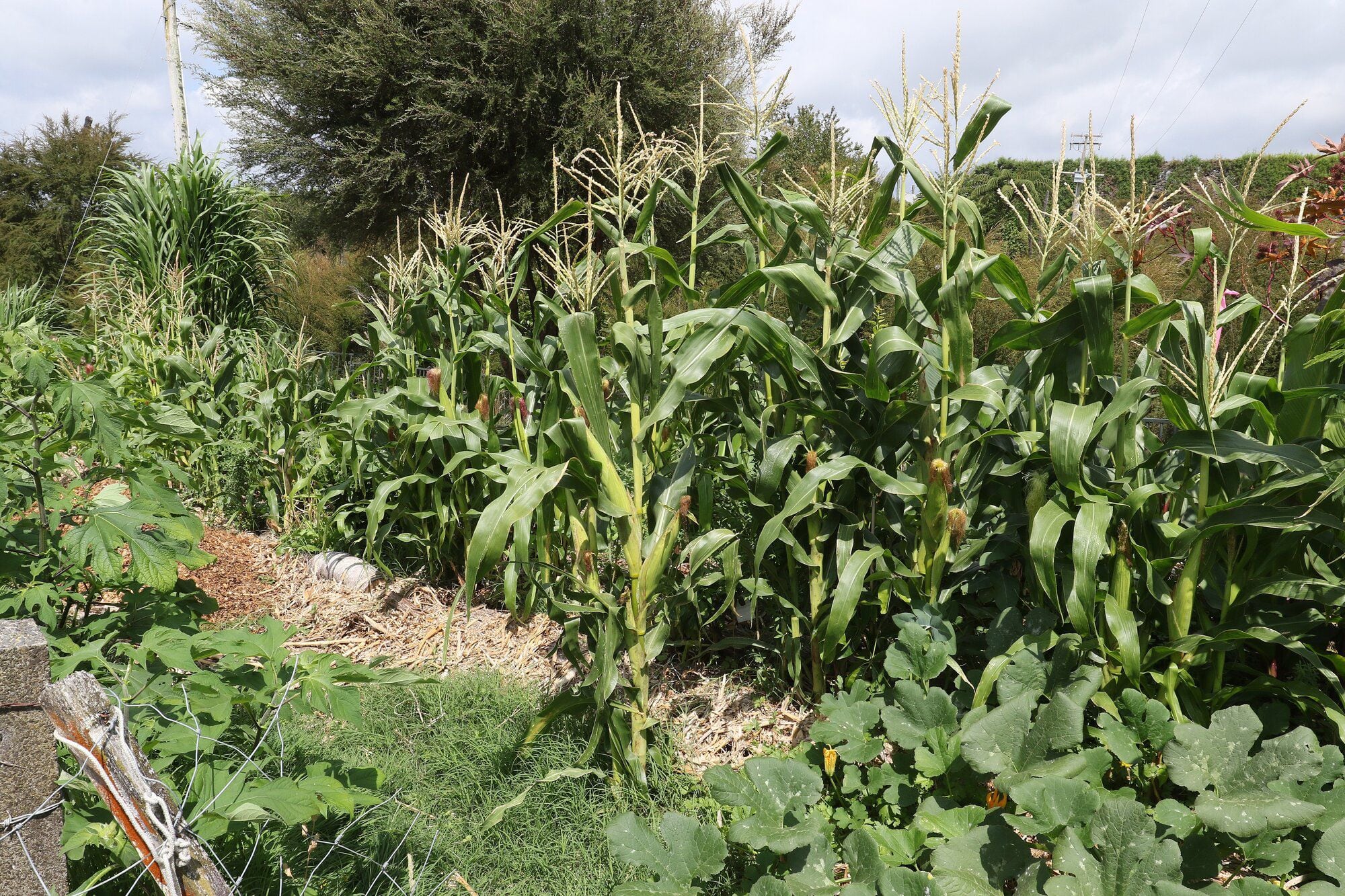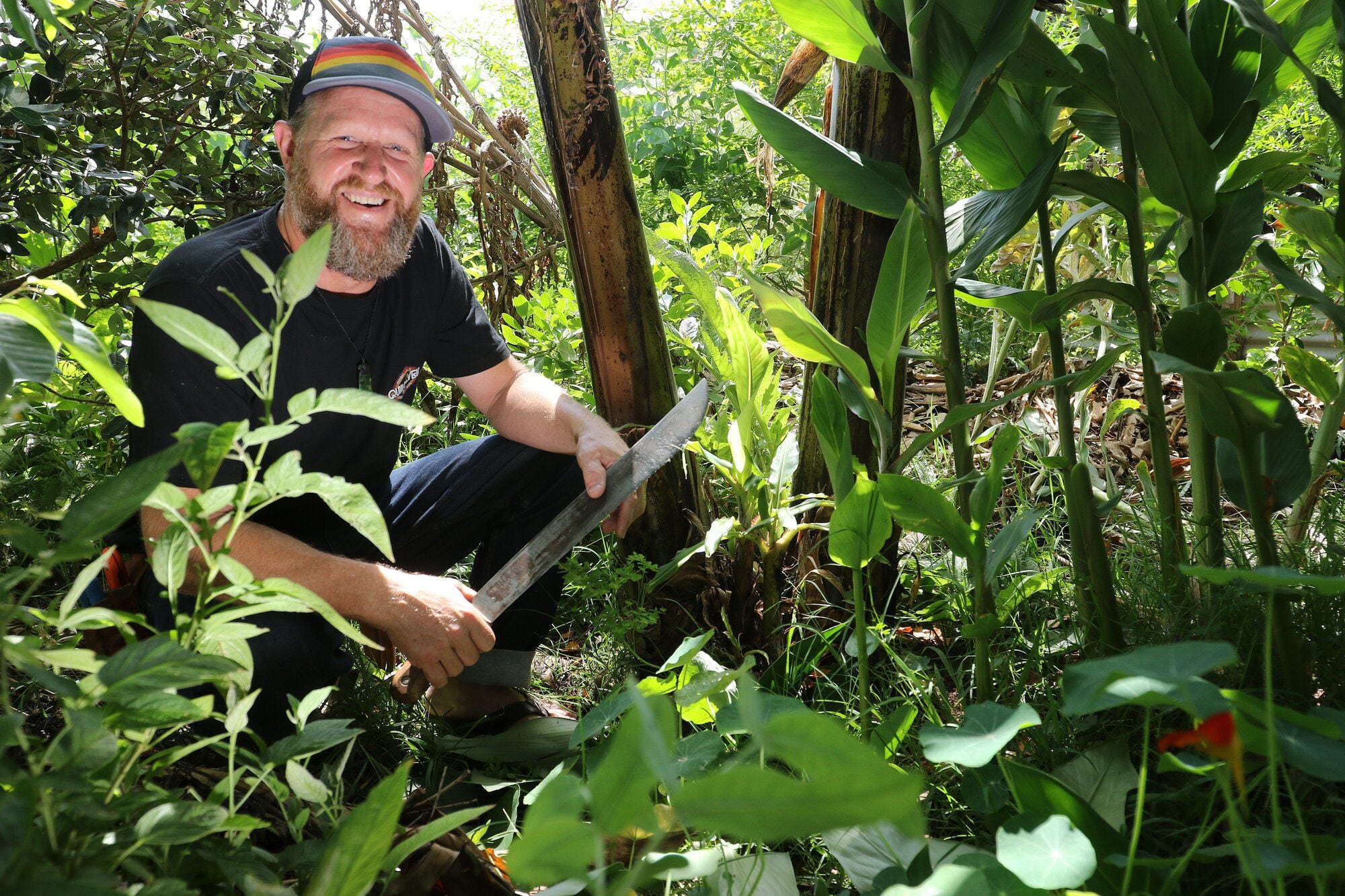Te Puke’s Kris Edgington believes the food growing potential of the Bay of Plenty is massively underestimated by its residents.
He has created MyFoodForest New Zealand and adopted the principles of syntropic agroforestry at his 3.2-hectare section to create a food forest that serves much of his family’s food needs in a nutrient dense, healthy way.
It is also a practical demonstration of what can be achieved.
Last year he travelled to Brazil, the birthplace of syntropic agroforestry, spending time with some of the world leading practitioners and at Sitio Semente, where founder Ernst Gotsch planted a food forest system over 40 years ago.
“It was absolutely amazing.”
The visit to Brazil consolidated a lot of his beliefs about how food production systems can be created sustainably.
Syntropic agroforestry creates a community of plants and is based on successional planting and creating an increasingly healthy soil.

Cavendish are one of many different types of banana grown on Kris Edginton’s Te Puke property. Photo: Stuart Whitaker
Edgington said after a couple of years, a well-designed food forest becomes relatively low maintenance.
“Once you’ve done the initial installation, which is a fair bit of work in the first couple of years, then it gets easier and easier. Then it’s about learning how to manage the system while you harvest.
“Correct planning and installation are key to success and can save you years and avoid many costly mistakes.”
A life-long journey
Edgington said his food forest in Te Puke was the culmination of his life’s journey so far and traces its roots back to his university days.
“My passion with healing human body and the earth and the soil started back in the 90s.”
He graduated in Australia as a naturopath.
“My passion back then was as a herbalist. I used to go out and collect all my medicinal herbs in Australia. It was a time where, I guess, alternative medicine/holistic medicine was not as mainstream as it is nowadays.”
He was living in Queensland, growing as much food as possible in a small area.
“The amount of food production you can do over there is just absolutely amazing, with it being a sub-tropical climate.
“So we used to produce food for friends and family mainly, that was when permaculture and all that sort of stuff was starting to take off. Now it’s got the label of food forest, but we were already doing that in a wild kind of way.”
He then changed tack and moved into hospitality, food preparation and cooking, spending time in Sydney and London where he married Kiwi Jodie.
Different places and varieties
They returned to Australia after the July 2005 London bombings, then moved to New Zealand in 2007, living in Rotorua for 10 years before moving to Papamoa.
There Edgington “decided to plant out a smallish section with 50 or 60 different species of edible and medicinal plants”.
The family moved to Te Puke a little over three years ago.
“When we arrived here there were only three edible plants — a couple of feijoas and a plum tree.
“Here is where we have really started to just put a lot of my knowledge of plant growth into the whenua.”

A small section of the food forest. Photo: Stuart Whitaker
Now there are hundreds of different varieties of plant on the property, with a surprising range including medicinal species and many Brazilian fruits, such as cheramoyas, pepino (a type of melon), sapote, dragon fruit and Brazilian grapes (jabuticaba).
“In the Bay of Plenty, so many people underestimate the growing food production potential of this climate — it’s unbelievable.
“We’ve got avocados and kiwifruit and those really are our major mono crops. Unfortunately, the majority of people think they can only grow basic fruit and veg, tomatoes, cucumber, a couple of apples and citrus. That’s the kind of mindset where a lot of people I think are at, but with a shift in knowledge and experimentation people here in the Bay will learn that the variety we can grow is just amazing.”
There are many different types of edible bananas on Kris’s property, including blue java, gold finger, cavendish, dwarf cavendish, mona lisa, mini luke along with many non-edible biomass species.
The starting principles
Syntropic agroforestry principles are based on strata layers to cater for different plants’ light needs, successional planting, time and understanding plant life cycles.
“It’s about starting to build a food production system that is not only going to be producing for one or two years but is going to be producing in five years, 15 years, 50 years down the track, like an intergenerational food production system.”
Alongside that are techniques that enhance soil quality and health. As the soil regenerates, becoming richer, more biodiverse, and teeming with microbial activity, it will rapidly improve.
As the soil strengthens, the next succession of plant species will thrive.
As these plants grow and are maintained they will further contribute to soil building and regeneration.
“With this style of production, you’ve got to change your mindset from the nice English garden where everything is manicured. Once people start to understand why it may not look so neat and tidy and what the biomass/organic material is actually doing to the soil, you start to think, there’s beauty in that.”
As a species, humans essentially rely on the top six inches of soil — which is why soil health is critical.
“All Mother Earth wants to do is create a forest and that’s such a powerful thing. Syntropic agroforestry actually speeds the natural growth process up.
Syntropic agroforestry also creates communities of plants.
“And we all know, when people are in communities, they thrive – plants are exactly the same.”
Growing interest
Edgington said for about 50 years, the skills and knowledge of vital food production in the backyard have been seen as unimportant but, for various reasons, there is now an increased interest in growing food and food sustainability,
“Our grandparents grew food, but through the 70s and 80s everyone kind of went away from backyard food production and the whole things around nutrient-poor convenience food came along. So did many of today’s illnesses.”
He says nutritional value of fresh fruit and veg has often been sacrificed for creating produce that looks good on supermarket shelves and has a longer shelf life.
“If we can get people back to eating good, nutritious food then the body’s going to do everything it can to heal itself, this is a win for everyone.
“There are a lot more farmers now opening up to the idea of reducing the chemicals, pesticides and herbicides they are using and building soil health. And people are starting now to become more open to other ways of food production.
“I believe that it is only a matter of time until this form of food production will in part be adopted by mainstream food production.”
Lockdown impact
The Covid lockdown also had an impact and led to an increase in general awareness around health and healthy eating.
“A food forest can be created in any backyard, from a square-metre food forest nest to a packed quarter-acre food forest system.
“It was a struggle when I first went into alternative lifestyles and started looking at holistic health because it was so alternative back then, but now the majority of society is actually open to thinking about that and at least thinking how their food production may have an impact on their health, which is a starting point.
“As a naturopath, I used to say ‘You are what you eat’. Unfortunately, with nutritional value of foods decreasing, these times have changed and now I say ‘You are what your plants and animals eat’.
“This is why it is so necessary to know how your food is produced.”

Kris Edgington among the plants of his food forest. Photo: Stuart Whitaker
He said there was also a wider role in growing our own food in rebuilding communities.
“Most people don’t know who their neighbours are, that’s how far people have gone down the silo effect.
“If, by planting a food forest, you can get people to talk to each other it’s only going to have a positive effect because it’s going to get people sharing and get them looking after each other.”
Motivated knowledge
Now Edgington is passing on his knowledge.
“A lot of my learnings have been motivated to heal the family and make sure we are as healthy as possible, but through that has come teaching other people how they can do it as well.
“It’s the cliché about teaching someone to fish rather than giving them a fish.”
He said everything from his days as a naturopath and herbalist in Australia, to his time in hospitality and his more recent learning about food production and syntropic agroforestry is all now beginning to dovetail.
Edgington will feature in the upcoming Flavours of Plenty Festival.
The festival programme will be launched on Friday.
Visit flavoursofplentyfestival.com/ for more.



0 comments
Leave a Comment
You must be logged in to make a comment.